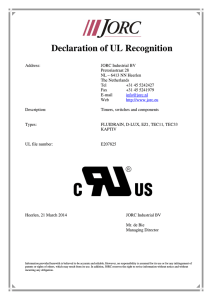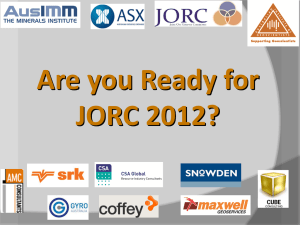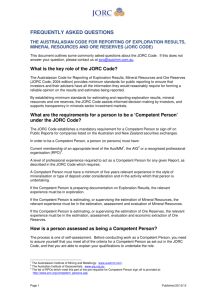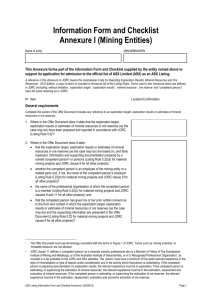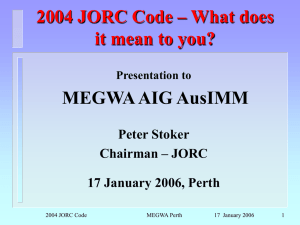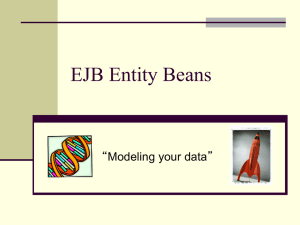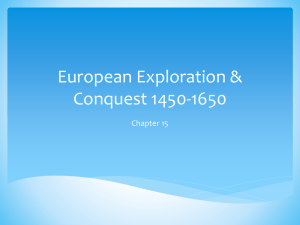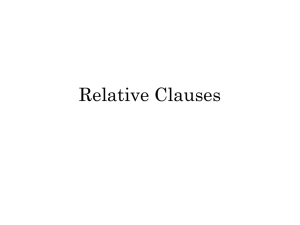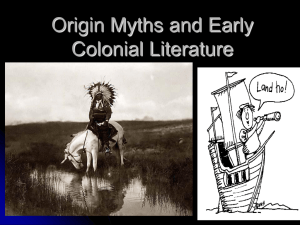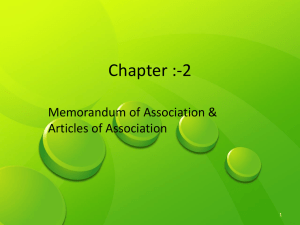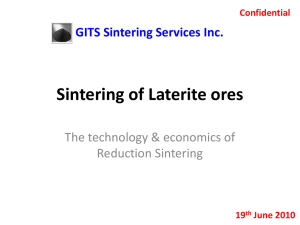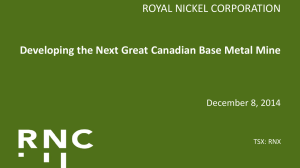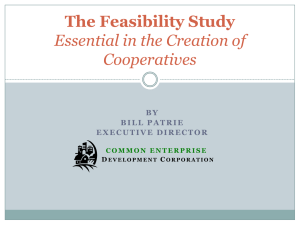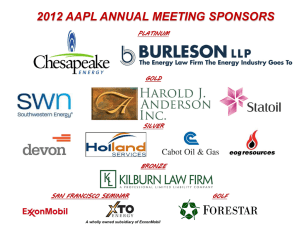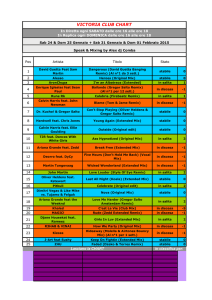JORC Code - MINEX Central Asia 2014. Mining and Exploration
advertisement
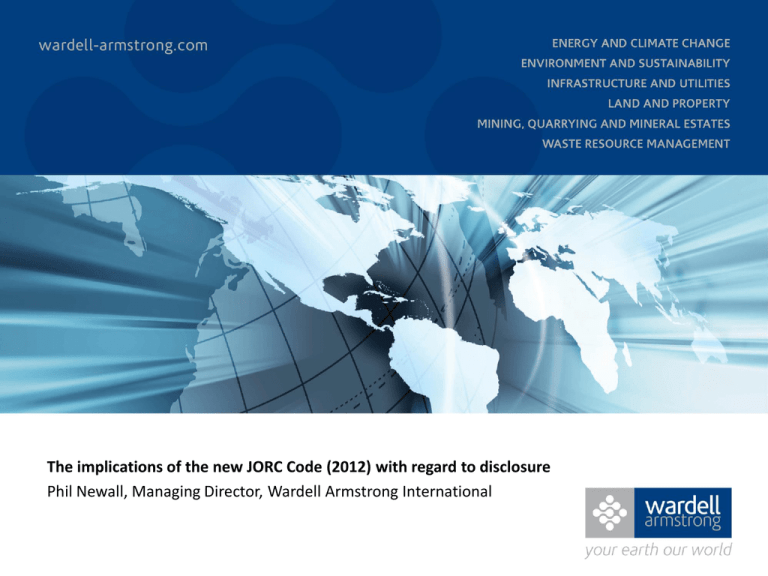
The implications of the new JORC Code (2012) with regard to disclosure Phil Newall, Managing Director, Wardell Armstrong International JORC Code (1989-2012) What is the JORC Code? • Australian Code for Reporting of Exploration Results, Mineral Resources and Ore Reserves Where it all began for JORC? • “Poseidon Boom in 1969 and 1970” First JORC Committee • Established in 1971 by AMIC; The Editions of JORC Code • First Edition in 1989, revised and updated in 1992, 1996, 2004 and now 2012 JORC Code, 2012 Edition supersedes all previous editions. JORC Code 2012 What does the JORC Code 2012 set out? • • • Minimum standards Recommendations Guidelines for Public Reporting What is the JORC Code? • • The Code is not a Code that regulates the methods used by Competent Person in Mineral Resource estimates; The term JORC compliant refers to the manner of reporting not to the actual estimates The Code is applicable to all solid minerals, including diamonds, other gemstones, industrial minerals and coal. Public Reporting (Clause 6) The Code is a required minimum standard for Public Reporting The aim of Public Reports is to inform: • • Investors Potential Investors and Investors Advisers on Exploration Results, Mineral Resources and/or Ore Reserves Public Reports, including those for: • • • ASX; NZX; Or other Regulatory Authorities including TSX, HKEX etc Effective and Mandatory Date! Latest version effective 20 December 2012 Mandatory from 01 December 2013 Main Principles of the JORC Code Competence Major Changes From 2004 Table 1 and “If not, Why not” Reporting (Clauses 2, 5, 19, 27, 35) Exploration Targets (Revised Clause 17) Competent Person Attributions (Clause 9) At Least a Prefeasibility Study Level for an Ore Reserve Declaration (Clause 29) Definition of Technical Studies (Clauses 37, 38,39 and 40) Metal Equivalents (Clause 50) In-situ or in ground values (Clause 51) Table 1 and “If not, Why not” Reporting Enhanced disclosure of material information by the Competent Person(CP) in line with information required by Table 1 (Clause 5 in 2012 Edition, no clause in 2004 Edition); Public Reporting should include detailed reporting of the relevant criteria from Table 1 of the Code, either for the first time or a material change since the last report; “If not, Why not” reporting (If CP has no comment about a relevant criterion, it should be explained in the report) The Technical Summary based against Table 1 criteria should be presented as an appendix to the Public Report. Table 1 Example Platina Resources Ltd, Updated Resource Estimate for the Skaergaard PGM-Au-Fe-Ti Deposit completed by WAI, Eastern Greenland in July 2013 . Exploration Target Clause 17 of the 2012 Code (amended Clause 18 of the 2004 Code) explains how Exploration Targets should be reported in Public Reports: • Exploration target must be quoted as a range of tonnes and a range of grade (or quality) with a detailed explanation of the level of exploration activity already completed; • Must include a clarification statement, stating conceptual in nature and no guarantee of conversion to Mineral Resource; and • The terms Resource and Reserve must NOT be used. Exploration Target Example A1 Consolidated Gold limited ASX Release-11th February 2013 Competent Person A Competent person (CP) is a minerals industry professional CP is Member or Fellow of AIMM, AIG or RPO (differs from 2004 when it was a ROPO) CP must have a minimum 5 years “relevant” experience in the type of deposits or style of mineralisation, and in the activity which that person is undertaking One CP may sign off the whole report (ie, taking full responsibility), or individual CP’s will be responsible for their sections. CP Role in Public Reporting A Public Report is the responsibility of the Company. With regard to CP requirements, the Company must: • • Disclose any relationship of the CP with the Company in the Public Report Where a company re-issues information previously issued, state the details of the original report and CP’s, with the consent of the CP. The 2012 Code provides: • • Appendix 2, Competent Person’s Consent Form Appendix 3, Compliance Statements Appendix 2 Competent Person’s Consent Form- Example Appendix 3 Compliance Statement Form - Example A1 Consolidated Gold Limited ASX Release – 11th February 2013 Competent Persons Statement The information in this Report that relates to in-situ Mineral Resources is based on information compiled by David Williams of CSA Global Pty Ltd. David Williams takes overall responsibility for the Report. He is a Member of the Australasian Institute of Mining and Metallurgy and has sufficient experience, which is relevant to the style of mineralisation and type of deposit under consideration, and to the activity he is undertaking, to qualify as a Competent Person in terms of the ‘Australasian Code for Reporting of Exploration Results, Mineral Resources and Ore Reserves’ (JORC Code 2012 Edition). David Williams consents to the inclusion in the report of the matters based on his information in the form and context in which it appears. (http://www.a1consolidated.com.au/images/uploads/A1S_11_05_R esource_Announcement_110213_Final.pdf) Reporting Terminology & Modifying Factors Public reports dealing with Exploration Results, Mineral Resources or Ore Reserves must only use the terms set out here: Modifying Factors are considerations used to convert Mineral Resources to Ore Reserves and include: • • • • • • • • • Mining Processing Metallurgical Infrastructure Economic Marketing Legal Environmental Social and governmental factors Minimum Pre-Feasibility Study Level for an Ore Reserve Declaration (1) One of the major changes and a new requirement in 2012 Edition (Clause 29), which brings the Code into line with the other international reporting codes and standards. Clause 29 states that at least a PreFeasibility level Study should have been completed to estimate an Ore Reserve; This new requirement establishes a minimum benchmark for the level of technical and economic study that is undertaken to examine the Modifying Factors as part of any Ore Reserve estimate that is included in a Public Report. Minimum Prefeasibility Study Level for an Ore Reserve Declaration (2) Deriving an Ore Reserve without a mine design or mine plan through a process of factoring of the Mineral Resource is unacceptable; In reporting of a new or materially changed Ore Reserve, the key underlying assumptions and outcomes of the Pre-Feasibility or Feasibility Study must be disclosed; and There must be reasonable grounds to expect that all necessary approvals (including Government) or sales contracts will be resolved within the anticipated time frame required by the mine plans. Minimum Pre-Feasibility Study Level for an Ore Reserve Declaration (3) In order to allow mining companies time to prepare, the clause (Clause 29) stipulating the need for a Pre- or Feasibility Study in order to define Ore Reserves does not come into effect until 1 December 2014. Companies in production that have a “Life of Mine” plan should have sufficient accurate data to be able to circumvent the need for such studies, but this will be up to the CP to decide. Technical Studies There is no equivalent to Clause 37-40 in the 2004 Edition. In new edition, a new section has been added to define and describe: • • • A Scoping Study Pre-Feasibility Study Feasibility Study The aim of these Clauses is to provide clarity on what is expected when reporting using these terms. Scoping Study An order of magnitude technical and economical study of the potential viability of Mineral Resources; Includes appropriate assessments of realistically assumed Modifying Factors and any other relevant operational factors; A basis for a Pre-Feasibility Study; The first economic evaluation of a project commonly and is based on low-level technical and economic assessments (+/- 35% accuracy or more); A Scoping Study must not be used as the basis for estimation of Ore Reserves; If the outcome of this study is supported by Inferred Mineral Resources and/or Exploration Target, the Public Report must state both the proportion and sequencing of these, and Must include a cautionary statement. Preliminary Feasibility Study Comprehensive study considering a range of options for the technical and economic viability of the project; Identifies a preferred mining method, an effective mineral processing method, infrastructure requirements and capacities (but is NOT final); Detailed assessments of environmental and socioeconomic impacts and requirements; Includes a financial analysis based on Modifying and other relevant factors to determine what proportion of Mineral Resources will be converted to Ore Reserves (no Inferred in Mine Plan); A lower confidence level than a Feasibility Study (+/- 25% accuracy); and Highlights areas that require further study for the final stage assessment. Feasibility Study Comprehensive technical and economic study of the selected development option of the project; Contains mining, infrastructure and process designs; Includes a detailed assessment of applicable Modifying Factors, operational factors (as outlined in Table 1) and detailed financial analysis to demonstrate that extraction is economically viable; Expect that all necessary approvals (social, environmental and governmental) will be in place or executed within the anticipated time frame; Basis for a final decision on investment or to support project financing; A higher confidence level than a Pre-Feasibility Study; and “Bankable Feasibility” and “Definitive Feasibility Study” are equivalent to a Feasibility Study. Metal Equivalents There is no equivalent Clause 50 in the 2004 Edition of the Code An extremely important new requirements for Public Reporting of Exploration Results, Mineral Resources or Ore Reserves in terms of “metal equivalent” Must show details of all material factors: • • • • • Individual grades for all metals Assumed commodity prices for all metals Assumed metallurgical recoveries for all metals and their source (metallurgical testwork, detailed mineralogy, similar deposits, etc) A clear statement on potential of the recovery and sales of all the elements included in the metal equivalents calculation The calculation formula used Metal Equivalents Example Platina Resources Ltd, Updated Resource Estimate for the Skaergaard PGMAu-Fe-Ti Deposit completed by WAI, Eastern Greenland in July 2013. In Situ, or In Ground Valuations No equivalent Clause 51 in the 2004 Edition of the Code Clause 51 introduces a new prohibition on the publication of “in situ” or “in ground” financial valuations in a Public Report Publication of these valuations are contrary to the intent of Clause 4 and 28; hence the terms are not transparent and lack material information To determine the project viability, it is necessary to include all reasonable Modifying Factors (Clauses 29-36) What are the other Codes? LSE and AIM Rules for Companies; PERC, CIM, SAMREC, JORC, SME, Russian code NI 43-101 and TSX and TSX-Venture Exchange policies; CIM, JORC, PERC, IG-7, SAMREC United States SEC Industry Guide 7, (SME) Certification Code for Exploration Prospects, Mineral Resources and Ore Reserves (IIMCH) Hong Kong Exchange Rules JSE Listing Rules: SAMREC JORC and ASX Industry Updates NI 43-101 and JORC (2012: Similarities Both require the involvement of a QP or CP (in Chile, Qualified Competent Person) and recognise foreign professional associations Definition of mineral resources and ore reserves are the same Preliminary Economic Assessment analogous to Scoping Study Definitions of Pre-Feasibility and Feasibility Study are the same Pre-Feasibility minimum standard for ore reserves NI 43-101 and JORC (2012): Differences NI 43-101 is a securities law (driven by lawyers) whereas JORC is a policy guideline (prepared by industry professionals) NI 43-101 applies to all oral and written disclosure of material information and is highly prescriptive, whereas JORC applies to written disclosure of exploration results and mineral resources and reserves and ultimately relies on the CP Technical reports: • • NI 43-101 – many triggers and reports filed on SEDAR JORC – technical reports not readily available – some commercially sensitive information can be omitted Summary More responsibility and accountability to the Competent Person; Sets out reporting pathway from Scoping through Pre-Feasibility to Feasibility Study; Exploration targets can only be defined through a range of tonnages and grades; QA/QC data vital to advance a project; Minimum Pre-Feasibility Study required for Ore Reserve reporting; Tighter controls on reporting Metal Equivalents and no In-situ valuations, and Brings JORC into line with other international codes through Transparency, Competence & Materiality pnewall@wardell-armstrong.com www.wardell-armstrong.com
